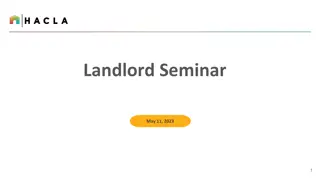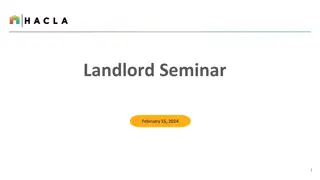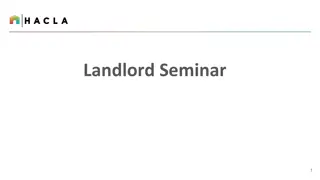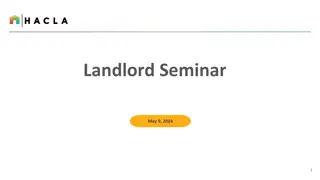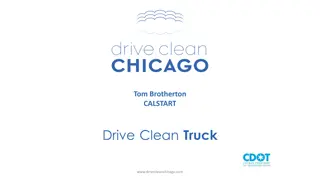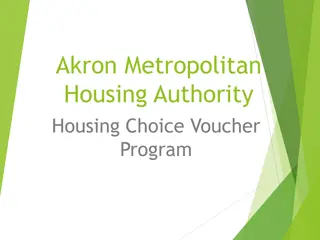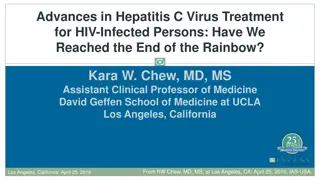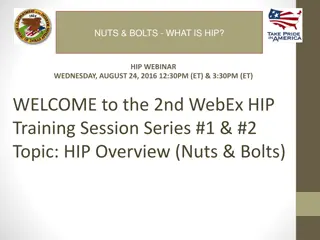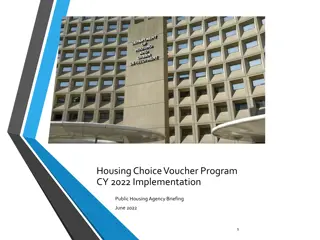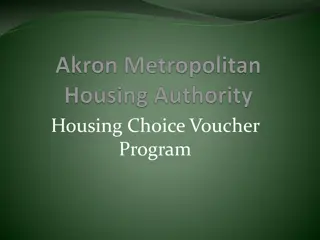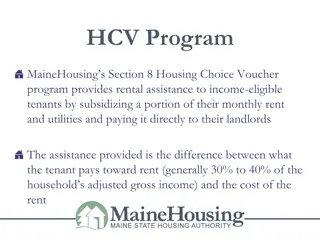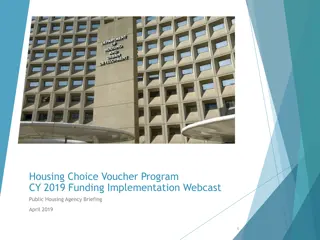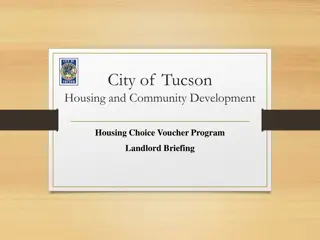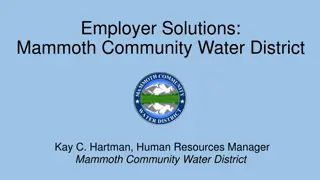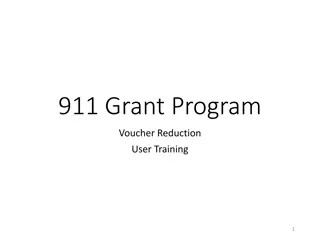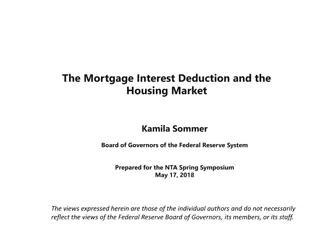Understanding the Housing Choice Voucher (HCV) Homeownership Program
The Housing Choice Voucher (HCV) Homeownership Program helps low-income, first-time homebuyers by providing monthly housing assistance payments. This presentation covers key aspects such as program overview, steps to develop the program, operations, counseling, eligible housing, inspections, financing, and policy requirements.
Download Presentation

Please find below an Image/Link to download the presentation.
The content on the website is provided AS IS for your information and personal use only. It may not be sold, licensed, or shared on other websites without obtaining consent from the author. Download presentation by click this link. If you encounter any issues during the download, it is possible that the publisher has removed the file from their server.
E N D
Presentation Transcript
Housing Choice Voucher (HCV) Housing Choice Voucher (HCV) Homeownership Program Homeownership Program 2022 1
Introduction The Housing Choice Voucher (HCV) Homeownership Program allows a Public Housing Authority (PHA) to make monthly housing assistance payments on behalf of low-income, first-time homebuyers to assist in meeting their monthly homeownership expenses. The HCV Homeownership Program is considered a special voucher type under the Housing Choice Voucher Program. 2
Purpose This presentation is designed to assist PHAs who are thinking about starting a homeownership program, or have already taken the first steps, and are wondering what to do next. Additional information including the Housing Choice Voucher Homeownership Guidebook, flyers and a webinar panel highlighting existing programs is available on the HCV Homeownership page on the HUD Exchange. Note: this presentation covers key points of program regulations but is not intended to be comprehensive. When planning a homeownership program, due diligence is recommended in reviewing regulations at 24 CFR 982.625 24 CFR 982.643 3
Topics Overview of the HCV Homeownership Program Steps to develop an HCV Homeownership Program Program operations Homeownership counseling Eligible housing Inspections Financing Post-purchase activities Policy development and program reporting requirements 4
Overview of the HCV Overview of the HCV Homeownership Program Homeownership Program 5
PHA requirements to operate A PHA must demonstrate that it has the capacity to operate an HCV homeownership program in one of the following three ways. 1. The PHA establishes a minimum down payment requirement of at least 3% of the purchase price, and at least 1% of the purchase price must come from the family s personal resources. 2. The PHA requires that financing: be provided, insured, or guaranteed by the state or federal government; comply with secondary mortgage market underwriting requirements; or comply with generally accepted private sector underwriting standards. 3. The PHA otherwise demonstrates in its Annual Plan that it has the capacity, or will acquire the capacity, to successfully operate an HCV homeownership program. 24 CFR 982.625 (g) 6
HCV homeownership basics The HCV Homeownership Program is considered a special housing type permitted under the PHA s Housing Choice Voucher Program. There is not a separate annual contributions contract between HUD and the PHA for homeownership vouchers, nor are there any special voucher allocations earmarked exclusively for homeownership use. Homeownership voucher assistance is tenant-based, meaning families can select a home to purchase anywhere within the jurisdiction of the PHA. 7
Purchasing a home with HCV assistance The process of buying a home with a voucher has many similarities to purchasing a home unassisted. Some differences include: A family must meet the PHA s eligibility criteria and qualify for a loan. A family must complete a homeownership counseling program. The PHA will likely have a significant role in helping a family find receptive lenders or will need to have strong partnerships with local agencies that support the homebuying process. 8
Voucher home buying Additional requirements when purchasing a home with a voucher include: The entire unit must be owner-occupied. The home must be within the PHA s jurisdiction. The home must pass two home inspections. The buyer may be not obligated to pay for any pre-purchase repairs. The seller may not have been debarred, suspended, or subject to a limited denial of participation. 9
Steps to develop an HCV Steps to develop an HCV Homeownership Program Homeownership Program 10
Planning for a homeownership program An assessment of the conditions necessary for a successful HCV Homeownership Program in your community and in your PHA will consider the factors below. For a homeownership program to succeed, four basic elements are needed: bankable program participants; affordable units; willing lenders; and agency and partner capacity to pull it all together. 11
Bankable program participants The first requirement for a successful HCV Homeownership Program is to have sufficient eligible, and bankable, participants. Families must have sufficient Income to meet the eligibility requirements. Families should have acceptable credit history; many otherwise eligible families have unacceptable credit risk scores and will require credit repair before they can qualify for a mortgage. 12
Affordable units For a homeownership program to work there must be an adequate supply of affordable housing units for sale. If the cost of a typical starter home in your area is well beyond what the voucher payment standards can support, you may have to work a little harder to identify other available resources. Some best practices include: Decreasing housing costs for program families by working in partnership with local agencies or other nonprofit developers who can write down the cost of the units or assist with other homeownership expenses. Explaining to the seller that this is a low-income family, sometimes they will be willing to assist with closing costs or negotiate price. Increasing the amount of down payment with homeownership grants, down payment assistance programs, second mortgages and other outside sources of housing funds. 13
Willing lenders Speak to as many lenders in the community as possible to identify and recruit lenders who will be willing to work with families receiving homeownership voucher assistance. Some best practices for recruiting willing lenders include: Developing relationships with lenders and real estate professionals. Maintaining the relationship by establishing a pattern of regular communications. Keeping track of all outreach efforts; even if a lender says no the first time they may respond differently over time. Maintaining professional looking materials and website, include testimonials and successful experiences. 14
Agency capacity Developing a successful homeownership program requires planning, partnership development, capacity building, and the ability to continuously interact with a new array of local agencies and financial institutions. Implementing a homeownership counseling program requires the ability to counsel and educate low-income families in all aspects of locating, financing, purchasing and maintaining a home. 15
Program operations Program operations 16
Outreach and briefing PHAs implementing an HCV Homeownership Program may wish to discuss the homeownership voucher option at voucher holders briefings for admission to the Housing Choice Voucher (HCV) Program, or at subsequent encounters, such as recertifications. 17
Initial requirements Before commencing homeownership assistance, the PHA must determine that the following initial requirements have been met: the family is qualified to receive homeownership assistance; the unit is eligible; and the family has completed the required homeownership counseling. 24 CFR 982.626 (a) 18
Eligibility Families admitted to the HCV Homeownership Program must meet additional requirements*, they must: qualify as first-time home buyers; meet income requirements; meet employment requirements; meet other eligibility standards; and complete a homeownership counseling program. PHAs may establish additional eligibility requirements which must be described in the Administrative Plan. *Except in the case of an elderly or disabled family 24 CFR 982.627 19
First-time homebuyer At the commencement of homeownership assistance, the family must be: a first-time homeowner (per 24 CFR 982.4 cited below); a cooperative member; or a family of which a family member is a person with disabilities, and use of the homeownership option is needed as a reasonable accommodation so that the program is readily accessible to such a person. 24 CFR 982.4 First-time homeowner. In the homeownership option: A family of which no member owned any present ownership interest in a residence of any family member during the three years before commencement of homeownership assistance for the family. The term first-time homeowner includes a single parent or displaced homemaker who, while married, owned a home with his or her spouse, or resided in a home owned by his or her spouse. 24 CFR 982.627(b) 20
Minimum income requirements At the time homeownership assistance begins, the adult members of a non-disabled family who will own the home must collectively meet a minimum, non-welfare, annual income requirement that is not less than the Federal minimum hourly wage ($7.25 in 2022)multiplied by 2,000 hours ($14,500). For a disabled family , the adult members who will own the home must have an annual income that is not less than the monthly Federal Supplemental Security Income benefit for an individual living alone ($841 in 2022)multipliedby 12 ($10,092). Minimum income eligibility only applies when determining if the family meets the requirement to participate in the homeownership voucher option. The PHA must follow the normal income definitions and rules for the Housing Choice Voucher Program for all other aspects of program administration, such as determining income for eligibility for admission to the Housing Choice Voucher Program, income targeting requirements, and rental or homeownership subsidy calculations. 24 CFR 982.627 (c) 21
Higher minimum income requirements PHAs may establish minimum income requirements higher than the HUD standard for either or both types of families (disabled and non-disabled), based on factors such as local housing costs and/or the practices of local lenders. However, families that meet the HUD minimum income requirement but do not meet the PHA s local minimum income requirement shall nevertheless be considered to meet the income requirement if: the family demonstrates that they have been pre-qualified or pre-approved for financing; the pre-qualified or pre-approved financing meets and PHA established requirements for financing the purchase of a home; and the pre-qualified or pre-approved financing amount is sufficient to purchase housing that meets HQS in the PHA s jurisdiction. 24 CFR 982.627(c)(3) 22
Minimum employment requirements One or more adult members who will own the home must: be currently employed on a full-time basis (not less than 30 hours per week on average); and have been continuously employed during the year before commencement of homeownership assistance. The PHA can set its own policies regarding what it considers continuous employment and may consider self-employment. The employment requirement does not apply to an elderly or disabled family (head, spouse or sole member is elderly or disabled), or a family that includes a person with disabilities, if other family members are unable to work on a full-time basis because they are required to care for the person with disabilities, and a reasonable accommodation is necessary. The PHA may not establish an employment requirement in addition to the HUD established employment requirement. 24 CFR 982.627(d) 23
Local program requirements Except where HUD has established mandatory eligibility criteria, PHAs have the option to adopt their own policies limiting homeownership assistance to families or purposes defined by the PHA. For example: A PHA may choose to limit participation to families who are current participants in the PHA s HCV program, or to families who are participants in, or have graduated from, a Family Self-Sufficiency program. A PHA may limit the number of families who will be permitted to exercise the homeownership option and may establish policies for selecting among eligible families who wish to participate. 24 CFR 982.626(b) 24
Reasonable Accommodation In the case where homeownership assistance is requested, the family demonstrates that the housing available to lease under the Housing Choice Voucher Program is not readily accessible to or usable by the family, and the nature of the disability of the disabled family member makes such an accommodation necessary, the PHA will determine if a reasonable accommodation is necessary on a case-by-case basis, based on the specific circumstances and individual needs of the person with the disability. 24 CFR 982.625(d)(2) 25
Homeownership counseling Homeownership counseling 26
Homeownership counseling Once a family has been selected for participation in the homeownership program and verified that they meet the requirements for participation, they must then complete a PHA-prescribed course of housing counseling provided by a HUD Certified Housing Counseling Program. In general, the goal of homeownership counseling is to ensure that homebuyers are prepared for homeownership and are mortgage-ready when they seek available lenders. The PHA may work with the housing counseling agency to adapt the subject covered in pre-assistance counseling to local circumstances and the needs of individual families. The PHA may offer additional counseling after commencement of homeownership assistance. The PHA has the discretion to determine whether they are required to participate in ongoing counseling. Homeownership counseling is an integral component of the HCV Homeownership Program. 24 CFR 982.630 27
Pre-assistance counseling components Pre-assistance counseling programs typically include: home maintenance; budgeting and money management; credit counseling; how to negotiate the purchase price of a home; how to obtain financing, including types of financing that may be available; how to find a home, including information about schools and transportation advantages of purchasing a home in an area that does not have a high concentration of low- income families and how to locate homes in such areas; information on fair housing; and information about the Real Estate Settlement Procedures Act (RESPA), state and federal truth- in lending laws, and how to identify and avoid loans with oppressive terms and conditions. 28
Eligible housing Eligible housing 29
Eligible Units The unit must: be an eligible unit; be a single-family dwelling, a manufactured home, or a single dwelling unit in a cooperative or condominium; have been inspected by a PHA Inspector and an independent inspector chosen by the family; and satisfy Housing Quality Standards (HQS). Homeownership assistance may be provided when the family will not own fee title to the land on which the home is located if: the home is located on a permanent foundation; and the family has the right to occupy the home site for at least forty years. 24 CFR 982.628(a) 24 CFR 982.628(b) 30
Housing Choices The type of housing that a family may choose includes: single-family house; condominium unit; cooperative (co-op) unit; site-installed manufactured housing; unit currently under a lease-purchase agreement; and PHA-owned or substantially controlled unit. 24 CFR 982.628 31
Single-family houses A one-unit property within the context of the program regulations, provides living space for one family, and is built on land owned by the family (or the family has the right to occupy the land for at least 40 years). The unit may be a detached unit, a semi-detached unit, a townhouse, or a row home. The characteristic that distinguishes this unit from a co-op or a condominium is that the family is purchasing the unit and the land on which the unit is built. These units are commonly owned in fee simple, a legal term for the form of homeownership in which the house and property (land) are owned by a single person or family. 32
Condominium units Condominiums are single-family units held under a form of homeownership in which the purchaser buys a one-family unit in a multi-family building or development. The unit that the buyer purchases consists of the living space enclosed by the exterior walls of the units, including interior partitions, cabinets, appliances and fixtures. The exterior walls of the unit including the roof, plumbing, and wiring and the common areas and grounds, are owned and maintained collectively by the condominium owners through a condominium association. The owner of a condominium unit pays a monthly fee to an association to cover the cost of exterior and common area maintenance and repairs. 33
Cooperative (co-op) units Cooperative units are single-family units in multifamily buildings or developments owned by a co-op association. Families who reside in the units have an equity interest in the property in the form of shares in the co-op association. Residents pay a monthly fee to the association that is used to pay expenses for the building or development including: monthly mortgage payments; utility, maintenance, and repair costs; taxes and insurance; and management expenses. 34
Site-installed Manufactured Housing Site-installed manufactured housing refers to manufactured housing installed on a permanent foundation. The land on which the manufactured unit is permanently installed may be owned, purchased by the family, or may be land that the family has the right to occupy for a period of at least 40 years. The Rural Housing Service also provides mortgage loans at extremely favorable terms for site-installed manufactured housing in rural areas. 35
Lease-Purchase Agreements A lease-purchase agreement is a purchase option under which the family leases a unit from an owner prior to purchase. The family initially pays rent for the unit and extra monthly payments to accumulate a down-payment or reduce the purchase price of the unit. The lease-purchase agreement itself is not considered a present homeownership interest in the property and does not preclude the family s future participation in the voucher homeownership program. An assisted family living in a rental unit under a lease-purchase agreement is eligible to receive rental assistance for the unit under the voucher program. In order to convert rental voucher assistance into homeownership assistance, the family must meet the eligibility criteria for homeownership assistance at the time they are ready to assume title to the property, not when they enter into the lease-purchase agreement. 36
PHA-Owned Units Homeownership assistance may be provided for the purchase of a unit that is owned by the PHA only if the following conditions are satisfied: The PHA must inform the family, both orally and in writing, that the family has the right to purchase any eligible unit and a PHA-owned unit is freely selected by the family. The unit is not ineligible housing. The PHA must obtain the services of an independent agency to: inspect the unit for HQS compliance; review the independent inspection report; review the contract of sale; and determine the reasonableness of the sales price and any PHA provided financing. 24 CFR 982.628(d) 37
Housing Search & Purchase Time Limits A PHA may establish time limits for families that have been approved for homeownership voucher assistance to find a home, and to complete the purchase of the property. These time limits may differ in length from the time limit provided to search under the rental program. If the family is unable to purchase a home within the time limit, the PHA may continue to assist a currently subsidized family, issue the family a voucher to lease a unit, or place the family s name on the waiting list for a voucher. 24 CFR 982.629 38
Portability A family in the HCV Homeownership Program may use portability to purchase a home in another PHA locality only if the new or receiving PHA locality has an HCV Homeownership Program and is accepting new families. In general, portability procedures are similar to portability procedures for HCV rental assistance. The family must attend briefing and counseling sessions required by the receiving PHA. 24 CFR 982.636 39
Inspections Inspections 40
Inspecting Homeownership Units The HCV Homeownership Program requires two inspections of properties: an initial Housing Quality Standards inspection conducted by the PHA; and a professional home inspection conducted by an independent inspector selected by the homebuyer. The unit must meet Housing Quality Standards before homeownership assistance may begin. 24 CFR 982.631(a) 41
The HQS Inspection The HQS inspection will include both the federal housing quality standards, and any additional local standards that are used in the administration of the rental assistance program. These additional provisions must be incorporated into the agency s voucher Administrative Plan. The seller must then be contacted to see if the seller will correct the HQS deficiencies prior to settlement. 42
Independent Inspection The unit must be inspected by an independent inspector selected and paid for by the family. The independent inspection must cover: major building systems and components; foundation and structure; housing interior and exterior; roofing; plumbing; electrical; and heating systems. The independent inspector must provide a copy of the inspection report both to the family and to the PHA. 24 CFR 982.631(b) 43
Contract of Sale The family must submit a copy of the contract of sale to the PHA. The agreement must include: the price and other terms of purchase; a provision for a pre-purchase inspection by an independent home inspector chosen by the purchaser; a provision that the purchaser is not obligated to purchase the unit unless the inspection is satisfactory to the purchaser; a provision that the purchaser is not obligated to pay for any necessary repairs; and the seller s certification that they have not been debarred, suspended, or subject to a limited denial of participation under 2 CFR part 2424. 24 CFR 982.631(c) 44
Housing Assistance Payment The housing assistance payment is equal to the lower of the payment standard or the actual monthly homeownership expense for the unit minus the total tenant payment. Monthly HAP payments can be paid either to the lender or directly to the family. 24 CFR 982.635(a) 45
Homeownership Expenses Homeownership expenses for a family (other than a cooperative member) may only include amounts to cover: principal and interest on initial mortgage debt, any refinancing of such debt, and any mortgage insurance premium incurred to finance purchase of the home; real estate taxes and public assessments on the home; home insurance; the PHA allowance for maintenance expenses; the PHA allowance for costs of major repairs and replacements; the PHA utility allowance for the home; principal and interest on mortgage debt incurred to finance costs for major repairs, replacements, or improvements for the home; and land lease payments, if applicable. 24 CFR 982.635(c)(2) 46
Homeownership Expenses for a Cooperative Owner Homeownership expenses for a cooperative member may only include amounts to cover: the cooperative charge under the cooperative occupancy agreement including payment for real estate taxes and public assessments on the home; principal and interest on initial debt incurred to finance purchase of cooperative membership shares and any refinancing of such debt; home insurance; the PHA allowance for maintenance expenses; the PHA allowance for costs of major repairs and replacements; the PHA utility allowance for the home; and principal and interest on debt incurred to finance major repairs, replacements, or improvements for the home. 24 CFR 982.635(c)(3) 47
F Financing inancing 48
Securing financing In the HCV Homeownership Program, the primary responsibility for securing the necessary financing rests with the family. The PHA is permitted and encouraged to partner and educate lenders in the community in order to assist in obtaining financing. However, a PHA may not require use of a particular lender or lenders. The family makes the selection, so long as the lender meets the qualifying criteria and conditions as set forth by the PHA. 24 CFR 982.632 49
PHA financing requirements The PHA may review lender qualifications and the loan terms before authorizing homeownership assistance. The PHA may disapprove proposed financing, refinancing or other debt if the PHA determines that the debt is unaffordable, or if the PHA determines that the lender or the loan terms do not meet PHA qualifications. In making this determination, the PHA may consider other family expenses, such as childcare, unreimbursed medical expenses, homeownership expenses, and other family expenses as determined by the PHA. All PHA financing or affordability requirements must be described in the PHA Administrative Plan. 24 CFR 982.632 50


